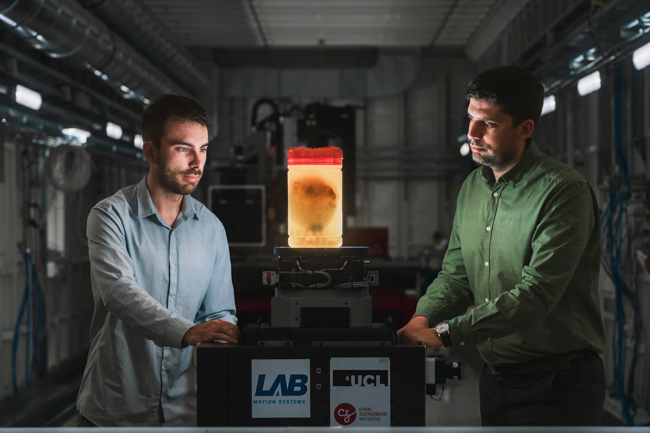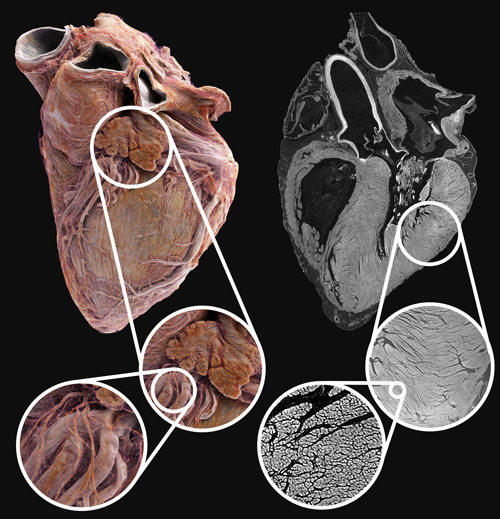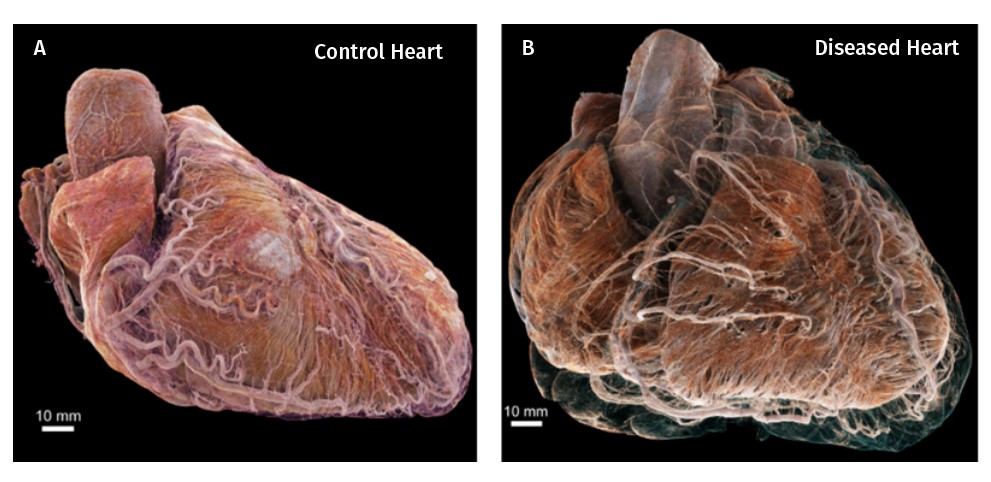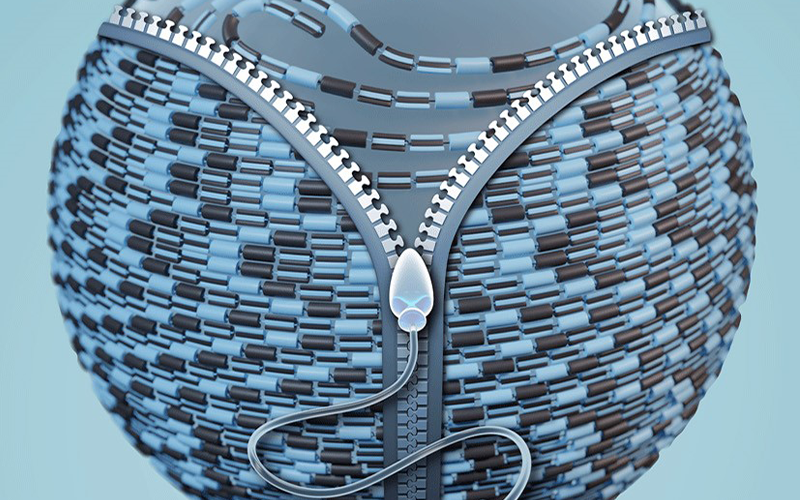
Accelerators are everywhere, perhaps closer than you think…
Did you know that there are more than 30 000 particle accelerators around the world? Where are they, and what are they for?

The following was adapted from an ESRF News article.
Heart of glass: a new X-ray scanning method reveals a full 3D view of the inside of the heart in incredible detail without having to cut into it.
Scientists led by University College London (UCL) and the European Synchrotron (ESRF) have, for the first time, imaged two whole human adult hearts, one healthy and one diseased, down to the cellular level in 3D.[1] They used a new X-ray technique called hierarchical phase-contrast tomography (HiP-CT), and this new atlas of the heart could potentially lead to medical applications.
To study the human heart, researchers typically use clinical imaging techniques such as ultrasound, computed tomography (CT), and magnetic resonance imaging (MRI). While these methods are effective for diagnosing cardiovascular disease, they do not reveal detailed structural changes across the different scales within the heart. For higher resolution, histology is required, which involves slicing donor organs into sections to view under the microscope. Although this method offers more detailed information, it only shows features on the cut surface, so things may be missed.
A new synchrotron X-ray imaging technique, called HiP-CT, overcomes these limitations by providing a detailed 3D view of the entire adult human heart.
The research team imaged two entire adult hearts, one healthy and one diseased, using the HiP-CT imaging technique on beamline BM18 at the ESRF. “BM18 is currently the only place in the world where complete human organs can be imaged with such a high level of contrast, and we are still quite far from the limits of the beamline capabilities. The main limiting factor is the processing of the very large data produced by HiP-CT”, explains Paul Tafforeau, ESRF scientist.

One of the major advantages of this technique is that it achieves a full 3D view of the heart at a resolution of 20 microns, which is around 20 times better resolution than a clinical CT scanner. For comparison, the width of a human hair is on the scale of around 100 microns.[2] In addition, it can then zoom in to cellular level at 2 microns (200 times better), allowing scientists to see structures at the cellular level without cutting the sample. This technique images whole organs, revealing details and connections that were previously unknown.

Whilst there have been synchrotron studies on whole fetus and small animal hearts before, these have always been at a tiny scale, 1 or 2 cm in diameter. In this new research, scientists have successfully imaged adult hearts of 14 cm in diameter for the first time.
Phase-contrast imaging differs from conventional X-ray imaging, which relies on X-ray absorption, by using the refraction of specific types of X-rays passing through tissues, rather than relying solely on X-ray absorption. It results in images with dramatically higher contrast and resolution, which is particularly beneficial for visualizing soft tissues and fine structures, as found in the heart, without the need for staining with a contrast agent.
The images revealed detail of the myocardium (muscle cells), valves, coronary arteries, and the cardiac conduction system (the electrical wiring that triggers heart contraction). “The first time you see the heart with HiP-CT, it is quite surprising, as it clearly shows soft tissue not typically visible with conventional X-ray imaging”, says Joseph Brunet, researcher at UCL and corresponding author of the publication.

A significant feat of the study is the detailed imaging of the cardiac conduction system, which generates and transmits the electrical signals that drive the heart muscle’s pumping action. The virtual sectioning of the conduction system provided scientists with information on fatty infiltration, vascular supply, and pathways between the cardiac nodes and adjacent structures. This level of detail on the entire adult heart conduction system was previously impossible.
“There is an enormous potential to inspire new treatments using this technique”, explains Professor Perry Elliot, Director of the Institute of Cardiovascular Science, UCL. An example of this is arrhythmia (irregular rhythm): “With today’s technology, having an accurate interpretation of the anatomy underlying arrhythmia is very difficult”, adds Professor Andrew Cook, heart anatomist at UCL and second author on the paper. “We believe that our findings will help researchers understand the onset of cardiac rhythm abnormalities and also the effectiveness of surgical ablation strategies to cure them”, he says. In particular, the results have shown that scientists can determine differences in the thickness tissue and fat layers located between the outer surface of the heart and the protective sac surrounding the heart. This information could be relevant when treating arrhythmia.
In addition to arrhythmia, HiP-CT could also shed light on other cardiovascular diseases. Anatomical studies using HiP-CT are currently underway to investigate congenital heart defects such as single ventricle disease. For the team, the next step is to increase the number of samples and to continue exploring the structural architecture of the heart in health as well as in disease, with the aim of developing innovative diagnostic and treatment strategies.
This work contributes to the Human Organ Atlas project, which aims to establish an open science image database of all human organs in health and disease. To explore this data yourself visit human-organ-atlas.esrf.eu, or for more information on the Human Organ Atlas project see mecheng.ucl.ac.uk/HOAHub/ and videos at bit.ly/HiP-CT-Heart.

The ESRF is the world’s brightest synchrotron light source. Every year, 9000 scientists from 20 partner countries and from around the world travel to Grenoble to use its extremely brilliant X-rays for leading-edge research. This fundamental and applied research contributes to addressing the complex global challenges that our society faces, such as health, energy, and the environment. It also contributes to the development of new technologies for industry and to preserving humanity’s cultural heritage, lighting the way to a sustainable and peaceful future.
The strength of the ESRF is its capacity to innovate, pushing the limits and seeking ever-higher performance for the benefit of the global scientific community. In 2020, the ESRF launched a brand-new generation of high-energy synchrotron, the ESRF’s Extremely Brilliant Source (EBS). With the support of the ESRF’s 20 partner countries, EBS provides scientists with new opportunities to unveil the structure of materials and the mechanisms of life, down to atomic resolution.
The project was co-funded by the Chan Zuckerberg Initiative (CZI). The team was led by UCL and the ESRF, in collaboration with the Wellcome Sanger Institute, Siemens Healthineers, Great Ormond Street Hospital, Hannover Medical School, the Aachen Medical University, the Helios University Clinic Wuppertal, the University Medical Center of the Johannes Gutenberg-University Mainz, and the Laboratoire d’Anatomie des Alpes Francaises (LADAF).
[1] Brunet J et al. (2024) Multidimensional Analysis of the Adult Human Heart in Health and Disease Using Hierarchical Phase-Contrast Tomography. Radiology 312: 1527–1315. doi: 10.1148/radiol.232731
[2] The width of a human hair on a visual tool for getting a sense of the scale of various objects: https://scaleofuniverse.com/en/universe/width-of-human-hair

Did you know that there are more than 30 000 particle accelerators around the world? Where are they, and what are they for?

Did you know that a squid’s brain is donut shaped, so that the oesophagus can pass through it? Or that squid have three hearts? Explore the fascinating physiology of squid in this hands-on activity.

You shall not pass: discover how the protein coating around an egg cell ‘zips up’ after fertilization to stop more sperm from entering.